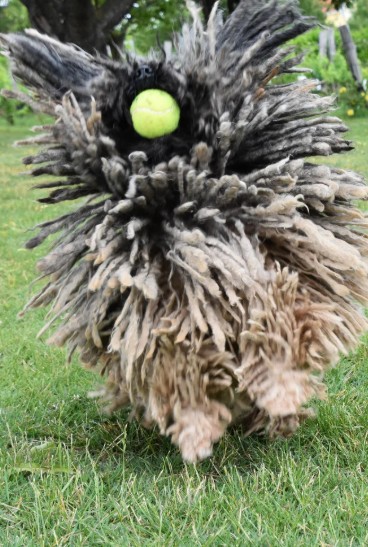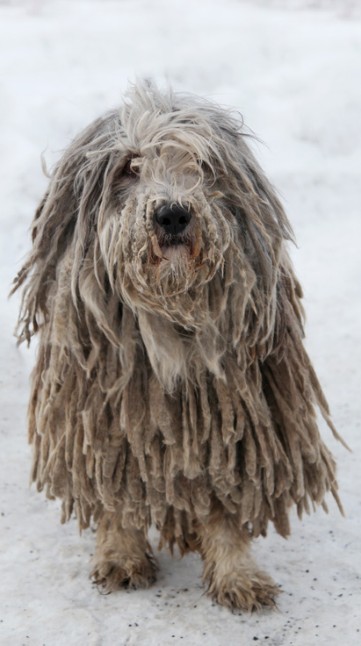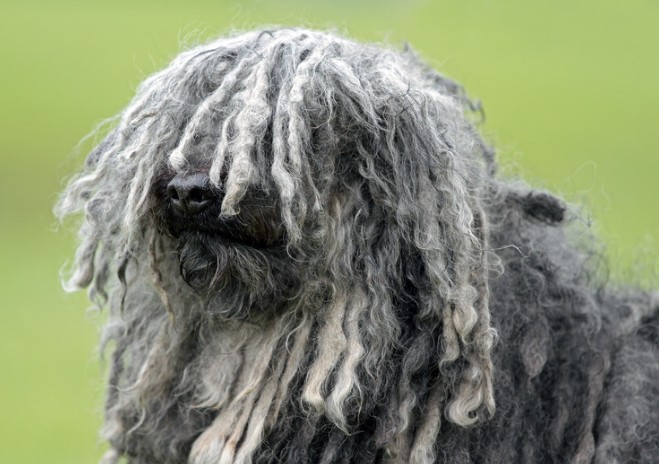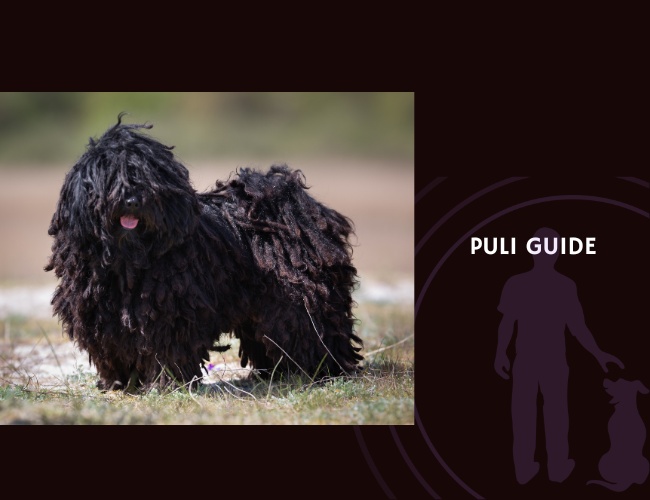Introduction
Picture a dog that looks like a living mop, bouncing through fields with cords flying in every direction, yet possessing the sharp intelligence and vigilance of a seasoned guardian. Welcome to the fascinating world of the Puli, Hungary’s ancient herding treasure. This remarkable breed, with its distinctive corded coat and spirited personality, has captured hearts for over a thousand years. Let us guide you through understanding these unique companions, from their herding heritage to their modern role as devoted family members.
Did you know that the Puli’s cords aren’t just for show? They’re a natural protective armor that once shielded these dogs from harsh weather and predator attacks while guarding flocks. Today, we’ll explore how this historical background shapes every aspect of your Puli’s behavior, care needs, and the special bond they form with their families. Whether you’re considering adding a Puli to your life or already share your home with one of these remarkable dogs, understanding their unique needs will help you build a trusting relationship that honors their heritage while meeting their modern needs. 🐾
Character & Behaviour
Understanding Your Puli’s Inner World
Your Puli’s character is a beautiful tapestry woven from centuries of purposeful breeding. These dogs aren’t just pets; they’re thinking, feeling beings with complex emotional lives shaped by their working heritage. You might notice your furry friend seems to be constantly “on duty,” scanning the environment with those alert eyes barely visible beneath their cords. This isn’t anxiety—it’s their natural guardian instinct at work.
Herding Instincts in Modern Life That sudden dash towards your moving bicycle or the gentle nudge they give your children toward the living room? Your Puli is expressing deeply ingrained herding behaviors. These motion-sensitive dogs possess what researchers call “predatory motor patterns,” specifically selected for livestock management. In your home, this translates to:
- Circling behaviors around family members during walks
- Gentle nipping at heels (especially with children)
- Intense focus on moving objects like cars, joggers, or skateboards
- Strategic positioning to keep the family “flock” together
Understanding these behaviors helps you redirect them appropriately. Your Puli isn’t being naughty when they chase the cat—they’re following instincts as old as their breed itself.
The Vigilant Guardian Pulik possess exceptional environmental scanning abilities, constantly processing sensory information to assess potential threats. This heightened awareness stems from their amygdala hypersensitivity—the same neurological trait that made them excellent livestock guardians. In your home, you’ll observe:
- Quick reactions to doorbell sounds or unfamiliar noises
- Careful observation of new visitors before acceptance
- Strategic positioning near windows or doors
- Alert body language even during apparent rest
This vigilance, while admirable, requires careful management to prevent it from developing into anxiety or excessive territorial behavior.
Emotional Intelligence & Bonding
The One-Person Dog Phenomenon Your Puli’s loyalty runs deeper than simple attachment. These dogs often form what ethologists call “selective social bonds,” showing clear preference for a primary caregiver while maintaining affectionate relationships with other family members. This bonding style reflects their historical role working closely with a single shepherd.
The oxytocin response in Pulik during bonding moments—those quiet times when your dog gazes into your eyes or leans against your leg—mirrors the same neurochemical processes seen in parent-child bonding. This biological foundation for their loyalty means:
- Your Puli may shadow their chosen person throughout the house
- Separation from their primary caregiver can cause genuine distress
- Trust, once earned, becomes unshakeable
- They may show protective behaviors toward their special person
Communication Through Voice Did you know your Puli’s bark contains a complex vocabulary? These vocal dogs use different tones, pitches, and patterns to communicate specific messages. Learning to decode your Puli’s vocalizations strengthens your bond and helps you respond appropriately to their needs.
Common vocal communications include:
- Short, sharp barks: “Alert! Something’s changed!”
- Deep, continuous barking: “Intruder warning!”
- High-pitched yips: “I’m excited!”
- Soft whines with eye contact: “I need something”
- Grumbling sounds: “I’m not happy about this”
Sensitivity to Routine
Your Puli thrives on predictability, finding comfort in established patterns. This isn’t inflexibility—it’s an adaptation that helped their ancestors efficiently manage their daily herding tasks. In modern life, this translates to a dog who:
- Anticipates walk times with remarkable accuracy
- Becomes unsettled by schedule changes
- Creates their own routines if none are provided
- Shows stress signals when routines are disrupted
Supporting your Puli’s need for structure doesn’t mean rigid adherence to schedules. Instead, it means creating predictable patterns within flexible boundaries, helping your companion feel secure while adapting to life’s inevitable changes. 🧡
Training & Education
Unlocking Your Puli’s Learning Potential
Training a Puli is like conducting an orchestra—it requires finesse, timing, and an understanding of your performer’s unique capabilities. These intelligent dogs don’t just learn commands; they analyze, problem-solve, and sometimes even anticipate what you’ll ask next. Let us guide you through educational approaches that honor their intelligence while building the skills they need for modern life.
The Multi-Step Thinker Your Puli’s brain processes information differently than many other breeds. Thanks to their herding heritage, they excel at sequential thinking and complex task completion. When teaching your furry friend, you’re working with a canine who can:
- Link multiple behaviors into behavior chains
- Remember command sequences even after long breaks
- Generalize learning across different contexts
- Problem-solve when standard approaches don’t work
This cognitive ability means you can teach sophisticated behaviors like “go to your bed, pick up your toy, and bring it to the kitchen.” Start with individual components, then chain them together using positive reinforcement markers.
High-Energy Learning Strategies Working with a Puli means engaging a mind that never truly rests. These active thinkers require training approaches that match their mental energy. Successful strategies include:
- Rapid-fire training sessions: Keep sessions short (5-10 minutes) but frequent
- Variable reward schedules: Mix treats, play, and praise unpredictably
- Movement-based learning: Incorporate physical activity into training
- Problem-solving games: Hide treats, use puzzle toys during training breaks
Remember, a bored Puli is a creative Puli—and their creativity might not align with your household rules!
Socialization: The Critical Foundation
Understanding the Socialization Window Between 3 and 14 weeks, your Puli puppy’s brain is particularly receptive to new experiences. This critical period shapes their future responses to the world. However, socialization doesn’t end at 14 weeks—it’s a lifelong process that requires thoughtful continuation.
During early socialization, focus on:
- Positive interactions with diverse people (different ages, appearances, mobility aids)
- Controlled meetings with well-behaved dogs
- Exposure to various environments (urban, rural, indoor, outdoor)
- Introduction to handling for grooming needs
- Familiarization with common household sounds and activities
Managing Herding Behavior Generalization Your Puli’s herding instincts don’t discriminate—without proper guidance, they’ll herd children, cats, and even adult humans. This requires specific training interventions:
- Interrupt and Redirect: When you see herding behavior beginning, interrupt with a positive interrupter (“touch” or “look”) and redirect to appropriate activity
- Provide Herding Outlets: Treibball, agility, or structured play can satisfy herding drives
- Teach Calm Observation: Reward your Puli for watching moving objects without reacting
- Use Management Tools: Baby gates or leashes prevent rehearsal of unwanted herding
Impulse Control: The Key to Harmony
Building Focus in High-Arousal States Pulik can shift from calm to highly aroused in seconds—a trait that served them well when protecting flocks. In your home, this quick arousal can lead to impulsive behaviors. Building impulse control requires patience and consistency.
Effective impulse control exercises include:
- Wait at Doorways: Teach your Puli to pause before crossing thresholds
- Leave It Challenges: Start with low-value items, gradually increasing difficulty
- Settle on Mat: Reward calm behavior during exciting activities
- Focus Games: Practice attention exercises with increasing distractions
Precision in Motion Your Puli’s agility and quick movements make precision training both challenging and rewarding. Activities like rally obedience or agility naturally develop body awareness and control. These sports channel their energy while building the precision needed for everyday life.
Cooperative Care: A Lifetime Investment
The Grooming Partnership Perhaps no aspect of Puli care requires more cooperation than grooming. Those beautiful cords don’t maintain themselves, and your dog’s comfort with handling directly impacts their quality of life. Start grooming desensitization from day one, even before cords begin forming.
Create positive grooming associations through:
- Touch conditioning: Pair handling with treats and praise
- Gradual duration increases: Start with seconds, build to full sessions
- Choice and control: Allow breaks when your Puli communicates need
- Predictable routine: Use consistent cues for grooming time
- High-value rewards: Reserve special treats exclusively for grooming
Remember, a Puli who enjoys grooming is a Puli who’ll maintain their magnificent coat throughout life. This investment in cooperative care pays dividends in reduced stress for both of you. 🐾

Nutritional Recommendations
Fueling Your Puli’s Active Lifestyle
Nutrition forms the foundation of your Puli’s health, affecting everything from their iconic coat to their cognitive function. These energetic dogs require more than just filling their bowl—they need carefully balanced nutrition that supports their unique physiology. Let us guide you through creating a nutritional plan that keeps your corded companion thriving.
Energy Requirements: Working vs. Companion Not all Pulik burn calories equally. Your dog’s energy needs depend dramatically on their lifestyle:
Working Pulik (active herding, agility, or sporting dogs):
- Require 40-50% more calories than sedentary dogs
- Need approximately 30-35 calories per pound of body weight
- Benefit from multiple smaller meals to sustain energy
- May require performance-specific supplements
Companion Pulik (typical family pets):
- Need approximately 20-25 calories per pound of body weight
- Thrive on consistent twice-daily feeding
- Require careful portion control to prevent weight gain
- Benefit from food puzzles to slow eating and provide mental stimulation
Always monitor your Puli’s body condition score—you should feel their ribs easily but not see them prominently beneath their cords.
Protein: The Building Block of Health
Quality Over Quantity Your Puli’s muscular, agile body demands high-quality protein sources. Look for foods where animal protein tops the ingredient list. Premium protein sources include:
- Deboned chicken, turkey, or duck
- Wild-caught fish (salmon, whitefish)
- Grass-fed beef or lamb
- Whole eggs
The amino acid profile matters as much as protein percentage. Pulik particularly benefit from:
- Leucine: Supports muscle protein synthesis
- Arginine: Promotes healthy blood flow and immune function
- Taurine: Essential for heart health
- Methionine and Cysteine: Critical for coat health
Aim for foods containing 25-30% protein for adult Pulik, with higher levels (28-32%) for working dogs or puppies.
Coat Health: Nutrition from the Inside Out
The Cord Connection Those magnificent cords require specific nutritional support. Your Puli’s coat health directly reflects their internal nutrition, and certain nutrients play starring roles:
- Omega-3 (EPA/DHA): Reduces inflammation, supports skin health
- Omega-6: Maintains skin barrier function
- Ideal ratio: 5:1 to 10:1 (omega-6 to omega-3)
Key Micronutrients for Cord Formation:
- Biotin: Promotes keratin production
- Zinc: Essential for coat pigmentation and texture
- Copper: Supports proper cord development
- Vitamin A: Maintains sebum production
- Sulfur compounds: Found in eggs and cruciferous vegetables
Consider supplementing with fish oil (1000mg per 30 pounds body weight) if your Puli’s diet lacks sufficient omega-3s.
Digestive Wellness
Finding the Right Feeding Method Pulik generally possess robust digestive systems, but individual preferences vary. You might notice your furry friend thrives on one approach while struggling with another:
Kibble Feeding:
- Choose high-quality, grain-inclusive or grain-free based on tolerance
- Soak in warm water for easier digestion
- Rotate proteins periodically to prevent sensitivities
Raw Feeding:
- Requires careful balance of muscle meat, organs, and bones
- May improve coat quality and reduce allergies
- Demands strict food safety protocols
Mixed or Fresh Feeding:
- Combines kibble with fresh toppers
- Increases palatability and nutritional variety
- Allows flexibility for travel or boarding
Monitor your Puli’s response through stool quality, energy levels, and coat condition. The best diet is one your individual dog thrives on.
Senior Nutrition: Supporting Graceful Aging
Adapting for the Golden Years As your Puli enters their senior years (typically around 8-10 years), their nutritional needs shift. These adjustments support healthy aging:
- Glucosamine and chondroitin: 500-1000mg daily
- Green-lipped mussel extract
- Turmeric with black pepper for absorption
- Omega-3 fatty acids at therapeutic doses
Cognitive Support:
- MCT oil: Provides alternative brain fuel
- Antioxidants (vitamins E and C, selenium)
- B-vitamins for neurological health
- DHA specifically for brain function
Adjusted Calories and Protein:
- Reduce calories by 20-25% if activity decreases
- Maintain high-quality protein to prevent muscle loss
- Consider more frequent, smaller meals
- Increase fiber for digestive health
Remember, nutritional changes should be gradual—sudden switches can upset your Puli’s sensitive system. Work with your veterinarian to create an individualized senior nutrition plan. 🧡
Health Concerns & Prevention
Safeguarding Your Puli’s Wellbeing
Understanding potential health challenges empowers you to provide proactive care for your corded companion. While Pulik are generally robust dogs with excellent longevity, awareness of breed-specific susceptibilities helps you catch issues early when they’re most treatable. Let us guide you through health considerations that deserve your attention.
Hip Dysplasia: Protecting Mobility Though Pulik are medium-sized dogs, hip dysplasia can still affect the breed. This inherited condition, where the hip joint doesn’t form properly, can lead to arthritis and mobility issues. Early detection and management make all the difference:
Prevention Strategies:
- Choose puppies from parents with OFA or PennHIP certification
- Maintain ideal body weight throughout life
- Avoid excessive jumping or stairs during puppyhood
- Provide joint-supporting nutrition from young age
Early Warning Signs:
- Bunny-hopping gait when running
- Difficulty rising from rest
- Reluctance to jump or climb stairs
- Shifting weight away from affected hip
If you notice these signs, don’t wait—early intervention through physical therapy, weight management, and appropriate exercise can dramatically improve outcomes.
Eye Health: Windows to Their World
Understanding Inherited Eye Conditions Your Puli’s expressive eyes, often hidden beneath their cords, require vigilant care. Two conditions particularly affect the breed:
Progressive Retinal Atrophy (PRA):
- Gradual deterioration of retinal cells
- Initially causes night blindness
- Progresses to complete vision loss
- Genetic testing available for some forms
Cataracts:
- Clouding of the lens
- Can be inherited or age-related
- May appear as early as 1-2 years
- Surgical correction possible in many cases
Schedule annual eye exams with a veterinary ophthalmologist, especially if your Puli:
- Bumps into objects in dim light
- Shows hesitation on stairs
- Has visible cloudiness in eyes
- Demonstrates behavior changes in new environments
Skin & Coat Challenges
The Unique Demands of Corded Coats Those beautiful cords create a microenvironment that can harbor problems if not properly maintained. Your Puli’s skin health directly impacts their comfort and behavior:
Common Cord-Related Issues:
- Hot Spots (Acute Moist Dermatitis):
- Develop quickly under matted cords
- Cause intense itching and discomfort
- Require immediate veterinary attention
- Prevented by proper cord separation
- Fungal Infections:
- Thrive in moist, dark environments
- Create musty odor
- Cause skin irritation and hair loss
- Managed through proper drying techniques
- Embedded Debris:
- Seeds, twigs can work into cords
- May cause infection if not removed
- Regular inspection essential
- Professional grooming may be needed
Prevention Protocol:
- Separate cords weekly, down to skin
- Ensure complete drying after bathing
- Use antimicrobial sprays in problem areas
- Monitor for unusual odors or behaviors
Bloat: A Critical Emergency
Understanding Gastric Dilatation-Volvulus (GDV) While not specifically common in Pulik, their active nature and deep chest create some risk for bloat—a life-threatening emergency where the stomach fills with gas and potentially rotates. Knowledge saves lives:
Risk Factors:
- Eating one large meal daily
- Rapid eating
- Exercise immediately after meals
- Stress during feeding
- Genetics and body conformation
Prevention Strategies:
- Feed 2-3 smaller meals daily
- Use slow-feeder bowls
- Wait 1-2 hours after meals before exercise
- Avoid elevated food bowls (controversial)
- Know your emergency vet’s location
Emergency Signs (seek immediate veterinary care):
- Unsuccessful attempts to vomit
- Distended, hard abdomen
- Excessive drooling
- Restlessness, pacing
- Pale gums
- Rapid heart rate
Time is critical with bloat—minutes matter. If you suspect GDV, don’t wait to see if symptoms improve.
Autoimmune Considerations
When the Immune System Misfires Though research on Puli-specific autoimmune conditions is limited, vigilance helps catch these complex disorders early:
Potential Autoimmune Manifestations:
- Symmetrical hair loss without infection
- Recurring skin lesions
- Chronic digestive issues
- Unexplained lethargy or fever
- Joint swelling in multiple locations
These conditions often require sophisticated diagnostics and ongoing management. Building a relationship with a veterinarian familiar with autoimmune disorders ensures your Puli receives appropriate care if needed.
Remember, most Pulik live healthy, active lives well into their teens. Regular veterinary care, attentive observation, and proactive management help your furry friend beat the odds and enjoy maximum vitality. 🐾
Curly. Clever. Hungarian.
The Puli is more than a mop—it’s a marvel of movement.
Beneath those iconic cords lies a lightning-fast herding mind, always alert, always calculating. This breed thrives on agility, structure, and meaningful work—it was never bred to be idle.
Pulis need purpose, not just play.
Without mental stimulation and consistent training, their intelligence can turn chaotic. They challenge routines, test boundaries, and require confident leadership rooted in respect, not domination.



Connection defines their loyalty.
When bonded deeply, the Puli becomes a shadow with a heartbeat—watching, working, and walking beside you with focused devotion. Earning that connection is a journey—but once achieved, it’s unshakable.
Performance & Activities
Channeling Your Puli’s Drive
Your Puli comes pre-programmed with centuries of working heritage—ignoring this drive is like trying to contain a river. These dogs need purposeful activity that engages both body and mind. Let us guide you through activities that honor their heritage while fitting modern lifestyles.
Agility: The Perfect Puli Sport Watch a Puli navigate an agility course, and you’ll witness poetry in motion. Their natural athleticism, combined with their problem-solving abilities, makes agility an ideal outlet:
Why Agility Works:
- Satisfies herding movement patterns
- Builds handler-dog communication
- Provides mental and physical challenge
- Offers social opportunities at clubs
- Adaptable to different skill levels
Start with foundation skills:
- Target training (nose touches)
- Body awareness exercises
- Jump grids at low heights
- Tunnel confidence building
- Contact equipment familiarization
Your Puli’s cords won’t slow them down—many corded Pulik compete successfully at high levels!
Herding: Honoring Heritage
Modern Herding Opportunities Even if you don’t own sheep, your Puli can explore their herding heritage through organized activities:
Herding Instinct Tests:
- Evaluate natural ability
- Provide controlled livestock exposure
- Build confidence around animals
- No prior experience needed
Treibball (Urban Herding):
- “Herd” large exercise balls
- Perfect for city dwellers
- Uses herding behaviors safely
- Great for impulse control
Traditional Herding Trials:
- Work with sheep, ducks, or cattle
- Learn traditional commands
- Develop partnership skills
- Connect with breed purpose
Many Pulik show remarkable instinct even without prior exposure to livestock—it’s literally in their DNA!
Mental Enrichment Activities
Scent Work: The Thinking Dog’s Game Your Puli’s intelligence demands more than physical exercise. Scent work engages their problem-solving abilities while providing calm, focused activity:
Getting Started:
- Hide treats in easy locations
- Add verbal cue (“search” or “find it”)
- Gradually increase difficulty
- Progress to specific scent discrimination
- Consider formal nosework classes
Benefits include:
- Mental fatigue (more tiring than physical exercise)
- Builds confidence in anxious dogs
- Can be done anywhere, anytime
- Suitable for all ages and fitness levels
- Strengthens dog-human communication
Puzzle Solving and Interactive Toys Invest in quality puzzle toys that challenge your Puli’s mind:
- Start with simple treat-dispensing balls
- Progress to multi-step puzzles
- Rotate toys to maintain novelty
- Create DIY puzzles from household items
- Use puzzles during meal times
Water Activities
Swimming: Therapeutic and Fun Despite their heavy-looking coat, many Pulik enjoy water activities. Their cords actually help them float! Swimming provides:
- Low-impact exercise for joints
- Full-body muscle engagement
- Cooling during hot weather
- Therapeutic benefits for seniors
- Alternative exercise during recovery
Water Safety for Corded Coats:
- Always supervise water activities
- Rinse thoroughly after swimming
- Ensure complete drying to prevent skin issues
- Consider a life jacket for deep water
- Start with shallow, calm water
Competitive Obedience and Rally
Precision Meets Personality Your Puli’s intelligence shines in obedience work, though their independent thinking adds interesting challenges:
Success Strategies:
- Keep training sessions varied
- Use high-value rewards
- Incorporate play between exercises
- Celebrate small improvements
- Maintain sense of humor!
Rally obedience particularly suits Pulik because it:
- Allows more natural movement
- Includes variety within routine
- Permits encouragement during performance
- Builds on herding directional cues
- Offers levels for all abilities
Therapy and Service Work
Sharing Your Puli’s Gift Well-socialized Pulik can excel in therapy work, bringing joy to hospitals, schools, and care facilities. Their unique appearance often serves as an conversation starter, while their intuitive nature helps them connect with people in need.
Qualities for Therapy Work:
- Calm demeanor in new environments
- Gentle with all people
- Comfortable with handling
- Non-reactive to medical equipment
- Reliable basic obedience
Remember, not every Puli suits therapy work—honor your dog’s individual temperament rather than forcing roles that create stress.
The key to a fulfilled Puli is variety—mix different activities to engage all aspects of their complex personality. A tired Puli is a good Puli, but a mentally satisfied Puli is a great companion! 🧡

Lifestyle & Environment
Creating Your Puli’s Perfect World
Your home environment profoundly impacts your Puli’s wellbeing. These adaptable dogs can thrive anywhere from city apartments to rural farms, but success depends on understanding and meeting their unique needs. Let us guide you through creating a lifestyle that brings out the best in your corded companion.
Space Considerations: Quality Over Quantity You might think Pulik need vast acreage to be happy, but that’s not necessarily true. What matters more is how you use your available space:
Apartment Living Success:
- Establish multiple daily exercise routines
- Create indoor enrichment stations
- Use vertical space for climbing activities
- Designate a “watching post” near windows
- Invest in sound-dampening materials for barking
Suburban Settings:
- Secure fencing is non-negotiable (minimum 5 feet)
- Create designated digging/activity zones
- Provide shelter from weather extremes
- Design obstacles for self-directed play
- Consider motion-activated toys for solo time
Rural Properties:
- Define boundaries even with acreage
- Protect from wildlife encounters
- Create safe spaces away from farm equipment
- Monitor for toxic plants or hazards
- Establish clear “working” vs “rest” areas
The Grooming Lifestyle Commitment
Living with Cords: A Daily Reality Choosing a Puli means accepting grooming as a lifestyle, not a chore. Your commitment directly impacts your dog’s health and happiness:
Daily Maintenance (10-15 minutes):
- Check for debris in cords
- Separate any cords beginning to mat
- Inspect skin at cord bases
- Clean face and sanitary areas
- Monitor for unusual odors
Weekly Sessions (1-2 hours):
- Systematic cord separation
- Thorough skin inspection
- Trim excess hair from feet
- Clean ears carefully
- Check between toe pads
Monthly Deep Grooming (3-4 hours):
- Complete cord-by-cord separation
- Bathing when needed
- Thorough drying process
- Nail trimming
- Full health assessment
This commitment intensifies during your Puli’s “cording years” (8 months to 2 years) when adult coat replaces puppy fur. Many owners find grooming becomes meditative bonding time—embrace it as connection, not burden.
Family Integration
Children and Your Puli Pulik can be wonderful family dogs, but success requires thoughtful management. Their herding instincts and sensitive nature need special consideration around children:
Age-Appropriate Interactions:
Toddlers (0-3 years):
- Always supervise interactions
- Teach gentle touching early
- Prevent chase games
- Create dog-free zones for both
- Watch for herding behaviors
School Age (4-11 years):
- Involve in training activities
- Teach respect for dog’s space
- Assign age-appropriate care tasks
- Encourage quiet bonding time
- Model appropriate play
Teenagers:
- Can take primary exercise responsibility
- Learn grooming techniques
- Participate in dog sports
- Understand breed characteristics
- Develop empathy through care
Setting Everyone Up for Success:
- Establish clear rules from day one
- Create separate spaces when needed
- Teach children to read dog body language
- Never punish growling (it’s communication)
- Celebrate positive interactions
Multi-Pet Households
The Puli in Your Pack Your Puli’s reaction to other pets depends on socialization, but their herding heritage influences all interactions:
With Other Dogs:
- May attempt to control movement
- Often prefer being “in charge”
- Can coexist peacefully with clear structure
- Same-sex aggression possible
- Need individual attention time
With Cats:
- Early socialization is critical
- Herding behaviors likely
- Can develop close bonds
- Require management during play
- Separate feeding essential
With Small Pets:
- Strong prey drive varies individually
- Never leave unsupervised
- Secure housing mandatory
- Positive associations possible
- Respect natural instincts
Exercise and Mental Stimulation Schedule
Crafting Your Daily Routine Pulik thrive on predictable patterns that meet their physical and mental needs:
Sample Daily Schedule:
Morning (6-8 AM):
- 30-45 minute walk or jog
- Training session during breakfast
- Grooming check
- Puzzle toy while you prepare for day
Midday (12-1 PM):
- Quick potty break and play
- Scent work or trick training
- Calm settling practice
- Interactive toy time
Evening (5-7 PM):
- Main exercise session (60-90 minutes)
- Could include: agility, fetch, swimming
- Social time at dog park (if appropriate)
- Training practice integrated with play
Night (8-10 PM):
- Final potty break
- Calm grooming session
- Chew toy or food puzzle
- Settle for evening
Adjust this framework to your lifestyle while maintaining consistency in timing and activity levels.
Environmental Enrichment
Creating a Stimulating Home Your Puli’s environment should offer choices and challenges:
Indoor Enrichment:
- Rotate toys weekly
- Hide treats in different locations
- Create obstacle courses with furniture
- Use food-dispensing toys for meals
- Provide various textures for comfort
Outdoor Enrichment:
- Digging pit with buried treasures
- Elevated platforms for surveying
- Various surfaces (grass, gravel, sand)
- Water features if possible
- Natural obstacles for jumping/climbing
Remember, a properly enriched environment reduces problem behaviors and increases your Puli’s quality of life. Investment in environmental design pays dividends in happiness for both of you! 🐾
Senior Care
Supporting Your Aging Puli
Watching your vibrant Puli transition into their golden years brings both tender moments and new challenges. These resilient dogs often maintain their spirited personality well into their teens, but thoughtful adjustments help them age gracefully. Let us guide you through providing compassionate care that honors your senior Puli’s changing needs while preserving their dignity and joy.
Recognizing the Senior Transition Pulik typically enter their senior years around 8-10 years old, though many don’t “act their age” until much later. Watch for subtle changes that signal aging:
Physical Changes:
- Slight stiffness after rest
- Longer recovery from exercise
- Graying around muzzle (visible in lighter dogs)
- Decreased jumping height
- More selective hearing (or actual hearing loss)
- Cloudiness in eyes
Behavioral Shifts:
- Increased sleep needs
- Less tolerance for disruption
- Stronger routine preference
- Possible anxiety in new situations
- Changes in appetite patterns
- Different play preferences
These changes happen gradually—keeping a journal helps you notice patterns and adjust care accordingly.
Adapting Exercise for Senior Needs
Movement as Medicine Your senior Puli still needs exercise, but the focus shifts from intensity to consistency. Regular, appropriate movement maintains muscle mass, joint flexibility, and mental wellbeing:
Modified Exercise Program:
- Shorter, more frequent walks (20-30 minutes, 2-3 times daily)
- Swimming for low-impact conditioning
- Gentle hill walking for strength maintenance
- Mental exercise replacing some physical activity
- Warm-up periods before activity
- Cool-down and stretching after
Signs to Slow Down:
- Heavy panting with mild exercise
- Limping or favoring limbs
- Reluctance to start activities
- Extended recovery periods
- Behavioral changes after exercise
Remember, your Puli may try to “push through” discomfort due to their working heritage—it’s your job to set appropriate limits.
Cognitive Health Maintenance
Keeping Minds Sharp Cognitive dysfunction syndrome (similar to human dementia) can affect senior dogs. Proactive mental stimulation helps maintain cognitive function:
Brain-Healthy Activities:
- New tricks or cue variations
- Novel walking routes
- Scent work and nose games
- Food puzzles of varying difficulty
- Social interactions with familiar dogs
- “Find it” games around the house
Warning Signs of Cognitive Decline:
- Disorientation in familiar places
- Changes in sleep-wake cycles
- House training accidents
- Decreased interaction with family
- Repetitive behaviors
- Anxiety or confusion
Early intervention with veterinary guidance can slow progression and improve quality of life.
Comfort Modifications
Creating a Senior-Friendly Environment Simple home modifications dramatically improve your aging Puli’s comfort and safety:
Indoor Adaptations:
- Orthopedic beds in multiple locations
- Non-slip rugs on smooth floors
- Night lights for navigation
- Raised food and water bowls
- Steps or ramps to favorite spots
- Baby gates to prevent falls
Grooming Adjustments:
- Shorter grooming sessions
- Warmer water for bathing
- Extra padding during grooming
- More frequent face and sanitary trims
- Gentle handling of arthritic joints
- Consider professional help if needed
Temperature Regulation: Senior Pulik may struggle with temperature extremes:
- Provide cooling mats in summer
- Consider cord trimming for easier maintenance
- Offer heated beds in winter
- Monitor for overheating during exercise
- Adjust indoor temperatures for comfort
Health Monitoring
Vigilant, Not Anxious Regular health monitoring catches issues early when they’re most treatable:
Twice-Yearly Vet Visits Should Include:
- Complete blood count and chemistry panel
- Thyroid function testing
- Urinalysis
- Blood pressure monitoring
- Weight and body condition assessment
- Dental examination
- Joint palpation and range of motion
Home Monitoring:
- Weekly weight checks
- Daily appetite observation
- Monitoring water intake
- Checking for lumps or bumps during grooming
- Noting changes in bathroom habits
- Observing breathing patterns at rest
Pain Management
Recognizing Hidden Discomfort Pulik, with their stoic working heritage, often hide pain until it becomes severe. Learn to recognize subtle signs:
Pain Indicators:
- Reluctance to be touched in specific areas
- Changes in grooming tolerance
- Altered gait or posture
- Increased vocalization or unusual quietness
- Appetite changes
- Withdrawal from family activities
Multimodal Pain Management: Work with your veterinarian to create a comprehensive pain management plan:
- Appropriate pain medications
- Physical therapy exercises
- Acupuncture or chiropractic care
- Massage therapy
- Heat/cold therapy
- Environmental modifications
Never give human pain medications without veterinary guidance—many are toxic to dogs.
Nutrition for the Golden Years
Feeding for Longevity Senior Pulik benefit from thoughtful nutritional adjustments that support aging bodies while maintaining quality of life:
Key Nutritional Modifications:
- Increased omega-3 fatty acids for joint and cognitive health
- Higher fiber content for digestive regularity
- Adjusted protein levels to maintain muscle mass
- Added antioxidants for cellular health
- Glucosamine and chondroitin supplementation
- Possible calorie reduction if activity decreases
Appetite Encouragement: If your senior Puli becomes a picky eater:
- Warm food slightly to enhance aroma
- Add low-sodium broth to kibble
- Offer smaller, more frequent meals
- Try different textures or flavors
- Hand-feed to encourage eating
- Rule out dental issues affecting eating
Quality of Life Considerations
The Difficult Decisions As your Puli’s advocate, you may face challenging decisions about their quality of life. Consider:
Quality of Life Indicators:
- More good days than bad
- Interest in favorite activities
- Appetite and hydration maintenance
- Ability to rest comfortably
- Continence (or manageable incontinence)
- Recognition of family members
- Moments of joy or contentment
Creating a Bucket List: Celebrate your senior Puli’s life with special experiences:
- Visit favorite places one more time
- Share special treats (in moderation)
- Arrange playdates with beloved friends
- Take photographs in meaningful locations
- Create paw print keepsakes
- Simply spend quiet time together
The Gift of Time
Treasuring Every Moment Your senior Puli has given you years of loyalty, laughter, and love. Now it’s your turn to give back through patient, compassionate care. These golden years, though sometimes challenging, often bring the deepest bonding as you become your dog’s trusted guide through aging.
Remember that every senior Puli ages differently. Some remain spry and mischievous well into their teens, while others slow down earlier. Honor your individual dog’s journey, adjusting care to meet their unique needs while preserving their dignity and celebrating their spirit.
The silver threads in their cords and the wisdom in their eyes tell the story of a life well-lived. Your commitment to their comfort in these final chapters is perhaps the greatest gift you can give your faithful companion. 🧡
Conclusion: Is the Puli Right for You?
Making the Lifetime Commitment
After exploring the fascinating world of the Puli, you’re probably wondering if this remarkable breed fits your lifestyle. These ancient Hungarian herders aren’t just dogs—they’re a lifestyle choice that brings immense rewards to the right homes. Let us guide you through the final considerations to help you make this important decision.
The Puli Owner Profile Successful Puli owners share certain characteristics that align with the breed’s needs:
You Might Be a Perfect Puli Person If You:
- Enjoy active participation in your dog’s life
- Find grooming meditative rather than tedious
- Appreciate intelligence, even when it challenges you
- Have patience for training a thinking dog
- Value loyalty and deep emotional bonds
- Can provide consistent exercise and mental stimulation
- Embrace uniqueness and enjoy answering questions about your dog
- Have time for significant grooming commitment
- Understand and respect herding behaviors
Consider Another Breed If You:
- Want a low-maintenance coat
- Prefer dogs who are instantly obedient
- Have limited time for exercise and training
- Dislike barking or vocal dogs
- Cannot commit to regular grooming
- Want a dog who loves everyone equally
- Lack secure fencing or containment
- Have no interest in managing herding instincts
The Rewards of Puli Partnership
What You’ll Gain Choosing a Puli brings unique joys that owners describe as life-changing:
- Unwavering Loyalty: Your Puli will choose you above all others, creating a bond that transcends typical pet-owner relationships
- Endless Entertainment: Their playful, intelligent nature provides constant amusement and surprise
- Active Lifestyle Partner: Your Puli will motivate you to explore, exercise, and engage with the world
- Conversation Starter: Those cords attract attention and create connections with fellow dog lovers
- Problem-Solving Companion: Watching your Puli think through challenges brings daily amazement
- Heritage Connection: You become part of an ancient tradition, stewarding a piece of living history
Practical Next Steps
If You’re Ready to Proceed:
- Research Reputable Breeders:
- Look for health testing (hips, eyes, genetics)
- Visit breeding facilities when possible
- Ask about temperament testing
- Request references from previous buyers
- Expect to wait for the right puppy
- Consider Rescue Options:
- Puli Club of America Rescue
- Breed-specific rescue organizations
- Local shelters occasionally have Pulik
- Be patient—Pulik rarely need rehoming
- Prepare Your Home:
- Secure fencing and gates
- Stock grooming supplies
- Find a groomer familiar with corded breeds
- Locate training classes
- Connect with local Puli owners
- Build Your Support Network:
- Join online Puli communities
- Find a veterinarian who knows the breed
- Identify emergency and specialty vets
- Connect with groomers experienced with cords
- Locate boarding facilities that understand breed needs
Your Journey Begins
Welcoming a Puli into your life opens a chapter filled with adventure, learning, and profound companionship. These remarkable dogs ask much of their humans—time, patience, understanding, and commitment—but they return these investments tenfold through their devotion, intelligence, and spirited partnership.
As you make this decision, remember that you’re not just choosing a pet. You’re selecting a companion who will challenge you to be more active, patient, and engaged with life. You’re becoming a guardian of an ancient breed whose history stretches back over a millennium. Most importantly, you’re opening your heart to a unique soul who will transform your daily routine into an adventure.
Whether you’re drawn to their striking appearance, their working heritage, or their loyal nature, make your choice with full understanding of what Puli ownership entails. If you can embrace the grooming, channel the energy, and appreciate the intelligence, you’ll discover why Puli owners rarely choose any other breed.
The Puli waiting for you—whether a bouncing puppy or dignified adult—will bring their whole heart to your relationship. The question is: are you ready to give yours in return?
For those who answer yes, welcome to the wonderful world of Puli ownership. Your corded companion awaits, ready to write the next chapter of this ancient breed’s story with you. 🐾
May your journey with your Puli be filled with muddy paws, flying cords, and boundless love. Here’s to the adventure ahead!










